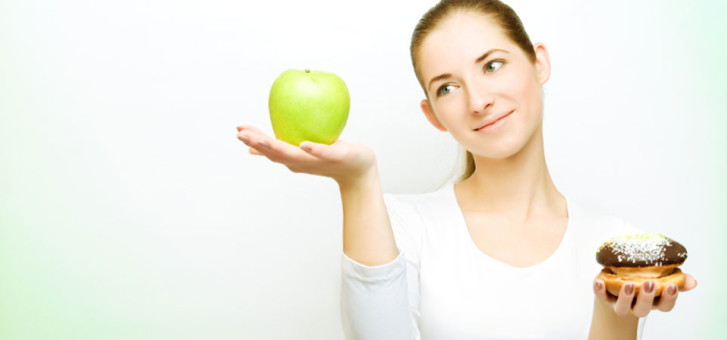While the age of information has its advantages, it has also resulted in misinformation and confusion regarding diet, nutrition and weight control.
It is important to have the right information about how food helps and hinders our health. False theories about dieting can result, at the least, in dissatisfaction with the results of our efforts, and at worst can be dangerous to our health.
Let's explore some of the most commonly taught myths and the truth that will help our health!
Myth 1: Food combining accelerates weight loss
The theory of food combining claims that eating wrong combinations of foods causes health problems because some foods cannot be digested together. According to the theory, eating carbohydrates together with protein will neutralise stomach acids, causing a build-up of toxins, and increased fat storage. Other claims include that meat will rot in your stomach unless eaten on its own, that you should only eat fruit raw before noon, or you should avoid drinking water with meals.
Fact: There is no scientific evidence to support these claims. Most foods contain a combination of carbohydrates, protein and fat, and these nutrients are not designed to be separated. Your body secretes a variety of digestive enzymes quite capable of breaking down any food or combination of ingredients. We also know your body absorbs more vitamins and minerals when your diet is made up of a wide mixture of different foods.
There is no justifiable reason to separate certain foods or drinks from others to aid weight loss. In fact, if your body did have trouble digesting food, it would actually be helpful to weight loss, because you would absorb fewer kilojoules. If you consider the fact that breast milk is designed for human infants, and that it contains a combination of all nutrients, this myth should be laid to rest.
Myth 2: It's hard for vegetarians to get all the nutrients they need
This myth is based on a 1970s study that discovered that rats grew best when fed a combination of plant proteins. It was then concluded that you had to combine plant proteins such as rice and beans to get a complete balance of protein nutrients (also known as amino acids).
Fact: Scientific studies on humans have since debunked this myth, but many people still believe it to be true. It's actually very easy for vegetarians to get all the nutrients they need without eating meat.
Although vegetarian diets vary considerably, food alone can supply all the nutrients you need as long as you eat a wide variety of fruits, vegetables, whole grains and legumes. Vegetarians who eat eggs, fish and dairy products have absolutely no problems getting all the essential nutrients.
Vegans, who eat only plant foods, can also get all the essential nutrients they need, although supplementation of iron and vitamin B12 might be required in some cases. Special care should also be taken by parents of young vegetarian children to ensure they get enough protein and kilojoules for growth and development.
Myth 3: Low-fat and fat-free foods will make you lose weight
Some people choose the low-fat or fat-free options when selecting food or drink because they have been told, or assumed, that these products
encourage or accelerate weight loss.
Fact: Eating a low-fat diet to lose weight is a bit like opening the bonnet of your car to repair the engine. It's a good start, but a lot more work is needed before you will see results. While eating less fat can reduce your kilojoule intake, this needs to be combined with a wider range of strategies to lose weight successfully.
First, some low-fat yoghurts, ice-cream, cakes and biscuits still have significant amounts of sugar. Low fat doesn't necessarily mean low kilojoule. Because people think these foods are healthy, they often eat larger portions, and can actually end up eating more kilojoules than the high-fat item they are substituting.
Alcohol has no fat, but you still have to burn off the alcohol before you burn off body fat. Every drink, therefore, slows the loss of fat. If your goal is fat loss, avoiding alcohol is the best solution—among the many other health and social reasons to avoid alcohol.
Finally, a low-fat diet might help you lose a little body fat, but it takes regular movement and exercise to remove existing stores of body fat over the long-term. Not only can exercise take your fat loss to a new level, it will also boost your health, strength, energy and self-esteem.
Myth 4: I have a sweet tooth
When someone is said to have a sweet tooth, it's used to describe cravings for sweet foods such as chocolates, cakes, biscuits, pastries, ice-cream and desserts.
Fact: These foods are not only sweet; they are all extremely high in fat. This presents the question: Is the sweet tooth just a fat tooth with a nicer name?
Eating sweet foods actually increases your appetite for more sweet foods due to the roller-coaster effect they have on blood sugar. They can also increase your fat intake. A recent study found people with “a sweet tooth” ate 12–14 g more fat each day compared to people who avoided sweets.
Additional research has shown women are more likely to have a sweet tooth than men. Women have a preference for sweet foods, especially as a source of comfort during periods of stress.
To see if your sweet tooth is really a fat tooth, try some sweet-only foods next time you have a craving. Foods like sorbet, jelly, boiled lollies, killer pythons, meringue and even fruit are all sweet, yet have virtually no fat. If your craving isn't satisfied after a sweet-only treat, then you might be getting more kilojoules than you think. Over the long-term, cutting back on sugar and processed fats is an important step to improving your health.
Myth 5: Bread, pasta, rice and potatoes are fattening
High carbohydrate foods like bread, pasta, rice and potatoes have become the most debated topic in nutrition. Some popular diets suggest they are fattening, and that it's best to cut them out if you want to lose weight.
Fact: This is only true if your portion sizes are high, and your activity levels are low.
It can also be the garnishes and sides with these foods that give them a fattening reputation. For example, the butter or margarine with bread, a creamy sauce with pasta, coconut milk with rice, full-cream milk with breakfast cereal and sour cream with potatoes. Excess kilojoules from any type of food will promote fat storage, and high carbohydrate foods are no exception.
Highly processed varieties of these foods, such as white pasta, white bread, white rice and low-fibre breakfast cereals are easy to overconsume because they are so low in fibre. They provide less fullness, so it's easy to eat too many kilojoules.
It's important to eat carbohydrates, as they are an important source of fuel for your body. But it's also important to monitor your portion size. Be aware of the quality of your carbohydrates, and include regular physical activity. Try to increase your intake of unrefined wholegrain carbohydrates, such as multigrain bread, brown pasta and rice, high-fibre breakfast and unpeeled potatoes. These low GI alternatives raise your blood-sugar levels at a slower pace, giving you fullness, energy and less chance of storing fat.
Myth 6: Foods with the heart tick can help you lose weight
Some people are persuaded to buy food with the red tick of foods approved by the National Heart Foundation because they believe those foods are the best foods for them to eat. Some people may believe food with the tick is better for losing weight than is food without the tick.
Fact: The tick program helps you to select foods that are a better choice for your heart within that category of foods. For example, the tick on a cheese label suggests that a particular cheese is a better choice—possibly lower in saturated fat or sodium—compared to some other cheeses on the market. Cheese can't be compared to other common foods that carry the tick, such as bread, margarine, biscuits, muesli bars, milk or meat.
Furthermore, food manufacturers pay for the tick. In some cases, customers may reject other cheeses that are a healthier choice because they don't have the tick, merely because that company didn't pay to have that product analysed by the National Heart Foundation.
Some of these foods with the tick are not necessarily great choices for your heart, such as hard cheese or margarine, and tick-approved foods may still contain cholesterol.
From a fat-loss perspective, the heart tick is of little value, as some of the foods will be unlikely to help you achieve your fat-loss goals. For example, a food might be tick approved because it is lower in saturated fat, but it could still contain the same high number of kilojoules from healthier fats.
While making a better choice for your heart is always a good choice, don't dismiss all foods without the tick. Some of the best food choices you can make for your heart and your waist are foods with minimal packaging, such as fruits, whole grains, vegetables and legumes.
Five diet warning signs
- Programs or boks that promise fast, miraculous results.
- Diets that suggest you cut out whole food groups
- Programs that promote a product or supplement as central to its success
- Disclaimers that the program myst be combined with exercises and a kilojoule-controlled diet.
- Diets that claim you can eat as much as you want, or that youdon't have to exercise.





